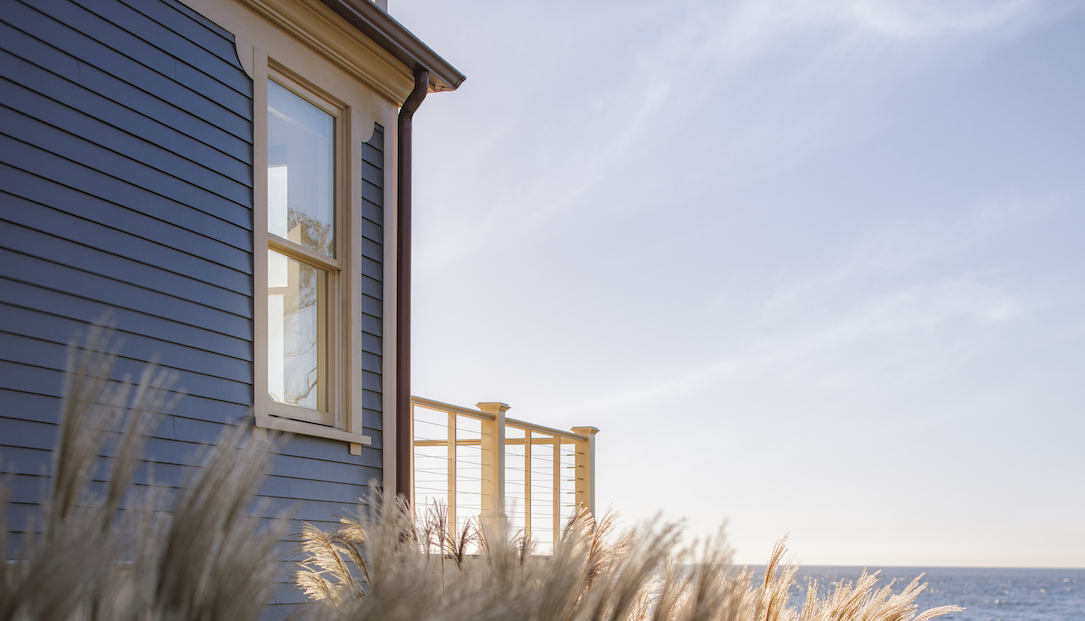Advanced design and engineering solve an old problem
The expansive appeal of inswing patio doors is easy to understand. What’s been more challenging to figure out was how to keep rainwater out during heavy rain. Inswing patio doors do away with the slightly raised, grooved tracks used by most sliding patio doors. Instead, they typically feature lower-profile sills that are great for offering a smooth transition between indoor and outdoor spaces but aren’t as good at keeping water out when heavy rain pelts the doors.
Minimizing water entry is a long-standing challenge with traditional sill design. Creating deep sill channels to handle rainwater increases sill height and creates a tripping hazard. Mechanical weep covers help, but are a magnet for debris, pet hair, insects, and dirt—often requiring maintenance or repair after a few years.
JELD-WEN’s Klamath Falls, Oregon–based Research and Development team used the latest advanced engineering and design technology to solve this vexing problem.
Advanced technology advantage
“The inswing door is a particular challenge because you have a lot more water on the weather stripping,” says Jacob Anderson, JELD-WEN product engineer. “It’s easier for water to get past the weather stripping and into the house.”
The project R&D team had a rough concept in mind—a corner key design that channels water through the sill, away from the home. However, the concept is one thing. Creating a market-ready solution that meets lofty requirements is another. To get there, the team’s advanced product development process began with computational fluid dynamics (CFD), a computer-based method to study fluid behavior. “We used CFD early on to look at water flow in general,” recalls Craig Abbott, who heads JELD-WEN’s R&D unit for wood windows and patio doors. “We realized that only got us so far. Our investigation is complicated to model because you have turbulence at multiple locations.”

Design. Iterate. Repeat.
Going beyond CFD meant creating a proprietary process built on continuous live prototype testing, says Derek Kindt, a JELD-WEN product designer who was instrumental in developing the testing process. This “Design-Iterate-Repeat” model captures data points in testing, which then provides information for new rapid prototypes. A continuous feedback loop is enabled by 3D printing, which reduces what would have been a six-month process to create a single prototype to just 24 hours, Abbott says. “We didn’t just develop a product. We pioneered a product development process that makes JELD-WEN quicker to market. We can meet customers’ needs even faster.”
“We could 3D print a new prototype each night, for testing the next day,” Abbott explains. “Then we test in the morning, gather results, make changes, and program the changes into the 3D printer for the next iteration the next morning.”
Patience makes perfect
The innovative new process proved essential. All told, the team investigated nearly 40 designs before tweaking and testing revealed a winner.
How does Hydrolock’s breakthrough design work? Watch this short animation to see how Hydrolock’s water management system helps keep outside water locked out and home interiors dry.
The door sill solution is a triumph of elegance, simplicity, and persistence. Abbott said the door sill’s final form isn’t radically different from the base concept, which focused on managing water, not trying to eliminate it. “We just need to capture and keep water within our system,” Anderson says. “The system ensures it’s returned to the exterior.” The sill employs a nonmechanical weep system that avoids the failure points that afflict competing inswing door systems. Other inswing door systems rely on mechanical weep covers that require maintenance and frequent replacement.
Enduring performance
Rigorous air, water, and structural testing verified the team’s faith. The patent-pending technology had targeted a performance grade of 40, based on several environmental factors. Hydrolock technology performed so well that it surpassed that expectation with a PG45 rating.
Is it fair to call Hydrolock a breakthrough? “Yes, absolutely,” Abbott confirms. “This product simply works all the time, every time. To achieve this rating, on this particular door style, is amazing.”
So what about Hydrolock on other patio door styles? Let’s just say no one in the R&D team is standing still.
For design assistance or help with window and door specifications or installation, visit JELD-WEN’s professional portal.




Comments are closed.